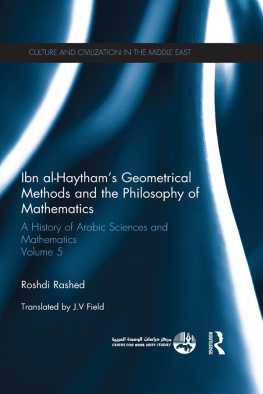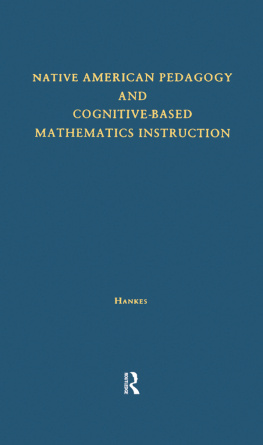Rāshid - Ibn al-Haytham’s geometrical methods and the philosophy of mathematics
Here you can read online Rāshid - Ibn al-Haytham’s geometrical methods and the philosophy of mathematics full text of the book (entire story) in english for free. Download pdf and epub, get meaning, cover and reviews about this ebook. year: 2017, publisher: Routledge, genre: Romance novel. Description of the work, (preface) as well as reviews are available. Best literature library LitArk.com created for fans of good reading and offers a wide selection of genres:
Romance novel
Science fiction
Adventure
Detective
Science
History
Home and family
Prose
Art
Politics
Computer
Non-fiction
Religion
Business
Children
Humor
Choose a favorite category and find really read worthwhile books. Enjoy immersion in the world of imagination, feel the emotions of the characters or learn something new for yourself, make an fascinating discovery.
- Book:Ibn al-Haytham’s geometrical methods and the philosophy of mathematics
- Author:
- Publisher:Routledge
- Genre:
- Year:2017
- Rating:5 / 5
- Favourites:Add to favourites
- Your mark:
- 100
- 1
- 2
- 3
- 4
- 5
Ibn al-Haytham’s geometrical methods and the philosophy of mathematics: summary, description and annotation
We offer to read an annotation, description, summary or preface (depends on what the author of the book "Ibn al-Haytham’s geometrical methods and the philosophy of mathematics" wrote himself). If you haven't found the necessary information about the book — write in the comments, we will try to find it.
Rāshid: author's other books
Who wrote Ibn al-Haytham’s geometrical methods and the philosophy of mathematics? Find out the surname, the name of the author of the book and a list of all author's works by series.
Ibn al-Haytham’s geometrical methods and the philosophy of mathematics — read online for free the complete book (whole text) full work
Below is the text of the book, divided by pages. System saving the place of the last page read, allows you to conveniently read the book "Ibn al-Haytham’s geometrical methods and the philosophy of mathematics" online for free, without having to search again every time where you left off. Put a bookmark, and you can go to the page where you finished reading at any time.
Font size:
Interval:
Bookmark:

This fifth volume of A History of Arabic Sciences and Mathematics is complemented by four preceding volumes which focused on the main chapters of classical mathematics: infinitesimal geometry, theory of conics and its applications, spherical geometry, mathematical astronomy, etc.
This book includes seven main works of Ibn al-Haytham (Alhazen) and of two of his predecessors, Thbit ibn Qurra and al-Sijz:
The circle, its transformations and its properties;
Analysis and synthesis: the founding of analytical art;
A new mathematical discipline: the Knowns;
The geometrisation of place;
Analysis and synthesis: examples of the geometry of triangles;
Axiomatic method and invention: Thbit ibn Qurra;
The idea of an Ars Inveniendi: al-Sijz.
Including extensive commentary from one of the worlds foremost authorities on the subject, this fundamental text is essential reading for historians and mathematicians at the most advanced levels of research.
Roshdi Rashed is one of the most eminent authorities on Arabic mathematics and the exact sciences. A historian and philosopher of mathematics and science and a highly celebrated epistemologist, he is currently Emeritus Research Director (distinguished class) at the Centre National de la Recherche Scientifique (CNRS) in Paris, and is the former Director of the Centre for History of Medieval Science and Philosophy at the University of Paris (Denis Diderot, Paris VII). He also holds an Honorary Professorship at the University of Tokyo and an Emeritus Professorship at the University of Mansourah in Egypt.
J. V. Field is a historian of science, and is a Visiting Research Fellow in the Department of History of Art and Screen Media, Birkbeck, University of London, UK.
General Editor: Ian Richard Netton
Professor of Islamic Studies, University of Exeter
This series studies theMiddle East through the twin foci of its diverse cultures and civilisations. Comprising original monographs as well as scholarly surveys, it covers topics in the fields of Middle Eastern literature, archaeology, law, history, philosophy, science, folklore, art, architecture and language. While there is a plurality of views, the series presents serious scholarship in a lucid and stimulating fashion.
For a full list of books in the series, please go to https://www.routledge.com/middleeaststudies/series/SE0363
PUBLISHED BY ROUTLEDGE
51. Eastern Rome and the Rise of Islam
History and Prophecy
Olof Heilo
52. Literature and the Islamic Court
Cultural life under al-ib Ibn Abbd
Erez Naaman
53. Women and Leadership in Islamic Law
A Critical Analysis of Classical Legal Texts
David Jalajel
54. Orthodoxy and Islam
Theology and Muslim-Christian Relations in Modern Greece and Turkey
Archimandrite Nikodemos Anagnostopoulos
55. Ibn al-Haythams Geometrical Methods and the Philosophy ofMathematics
A History of Arabic Sciences and Mathematics Volume 5
Roshdi Rashed
56. New Horizons in Quranic Linguistics
A grammatical, semantic, and stylistic analysis
Hussein Abdul-Raof
A History of Arabic Sciences and Mathematics
Volume 5
Roshdi Rashed
Translated by
J. V. Field


First published 2017
by Routledge
2 Park Square, Milton Park, Abingdon, Oxon OX14 4RN
and by Routledge
711 Third Avenue, New York, NY 10017
Routledge is an imprint of the Taylor & Francis Group, an informa business
2017 Roshdi Rashed and CAUS
The right of Roshdi Rashed to be identified as author of this work has been asserted by him in accordance with sections 77 and 78 of the Copyright, Designs and Patents Act 1988.
All rights reserved. No part of this book may be reprinted or reproduced or utilised in any form or by any electronic, mechanical, or other means, now known or hereafter invented, including photocopying and recording, or in any information storage or retrieval system, without permission in writing from the publishers.
Trademark notice: Product or corporate names may be trademarks or registered trademarks, and are used only for identification and explanation without intent to infringe.
Publishers Note
This book has been prepared from camera-ready copy provided by the author
British Library Cataloguing in Publication Data
A catalogue record for this book is available from the British Library
Library of Congress Cataloging in Publication Data
The Library of Congress has cataloged volume 1 of this title under the
LCCN: 2011016464
ISBN: 978-0-415-58219-3 (hbk)
ISBN: 978-1-315-16845-6 (ebk)
Typeset in Times New Roman
by Taylor & Francis Books
I. Fakhr al-Dn al-Rz:
Ibn al-Haythams critique of the notion of place as envelope
II. Al-asan ibn al-Haytham and Muammad ibn al-Haytham:
the mathematician and the philosopher On place
This book is a translation of Les Mathmatiques infinitsimales du IXe au XIe sicle, vol. IV: Mthodes gomtriques, transformations ponctuelles et philosophie des mathmatiques. The French version, published in London in 2002, also included critical editions of all the Arabic mathematical texts that were the subjects of analysis and commentary in the volume.
It also included: 1. Les emprunts dIbn Hd aux Connus et LAnalyse et la Synthse (Ibn Hds borrowings from The Knowns and On Analysis and Synthesis); 2. Al-Baghdd critique dIbn al-Haytham (Al-Baghdd as a critic of Ibn al-Haytham), with the critical edition of the Arabic text, French translation and mathematical commentaries.
The whole book, apart from these two appendices, has been translated, with great scholarly care, by Dr J. V. Field. The translation of the primary texts was not simply made from the French; I checked a draft English version against the Arabic. This procedure converged to give an agreed translation. The convergence was greatly helped by Dr Fields experience in the history of the mathematical sciences and in translating from primary sources. I should like to take this opportunity of expressing my deep gratitude to Dr Field for this work.
Very special thanks are due to Aline Auger (Centre National de la Recherche Scientifique), who helped me check the English translations against the original Arabic texts, prepared the camera ready copy and compiled the indexes.
Roshdi Rashed
In his magisterial Aperu historique, Michel Chasles, having given the titles of books and referred to the achievements of the great geometers of the Hellenistic period, writes:
[] then, for two or three centuries more, there came the writers of commentaries, who have passed on to us the works and the names of the geometers of Antiquity; then finally the centuries of ignorance, during which Geometry slumbered among the Arabs and the Persians until the Renaissance of learning in Europe.
In this peremptory judgement, Chasles, whose good faith cannot be doubted, was setting out what was known by historians in the mid nineteenth century rather than describing historical facts. At the time, investigations into the history of geometry in classical Islam were few and scattered, and it is not surprising that Chasles judgement became the received opinion. And indeed we find it repeated tirelessly in the historical introductions to manuals of geometry, such as that by Robert Deltheil and Daniel Caire, as well as in writings penned by historians of geometry, even sometimes up to the present day. Nevertheless, a little later a better, though still far from satisfactory, grasp of the historical facts struck the first blows against this general prejudice. Today, for the majority of historians of mathematics, the opinion for which Chasles was the spokesman has given way to a different one, less absolute without however being more accurate, which could be summarised as follows: Arab geometers, while they never reached the high level of the geometry of the classical Greeks, did at least have the merit of recognising the importance of their work and of having preserved both its spirit and its matter, even going so far as to add several notable details. For this, the names that are mentioned are those of Thbit ibn Qurra and of Nar al-Dn al-s. Although it is more nuanced, but also more eclectic, this way of looking at things in fact derives from the same logic: to stop at the threshold of questions, without indicating the criteria and setting out the reasoning that could have led to this modest contribution to geometry. It is not clear why, according to the proponents of this theory, the geometers of classical Islam should have thus confined themselves to the role of conscientious preservers of the Hellenistic geometrical heritage, while they were making major advances in all the other disciplines: algebra, number theory, trigonometry, and so on. It is inexplicable that the notable developments in these latter disciplines and in mathematised disciplines such as astronomy and optics should have had so little effect on work in geometry. It is not clear why the single exception made by the historians of mathematics should be for the development of the theory of parallel lines.
Next pageFont size:
Interval:
Bookmark:
Similar books «Ibn al-Haytham’s geometrical methods and the philosophy of mathematics»
Look at similar books to Ibn al-Haytham’s geometrical methods and the philosophy of mathematics. We have selected literature similar in name and meaning in the hope of providing readers with more options to find new, interesting, not yet read works.
Discussion, reviews of the book Ibn al-Haytham’s geometrical methods and the philosophy of mathematics and just readers' own opinions. Leave your comments, write what you think about the work, its meaning or the main characters. Specify what exactly you liked and what you didn't like, and why you think so.












